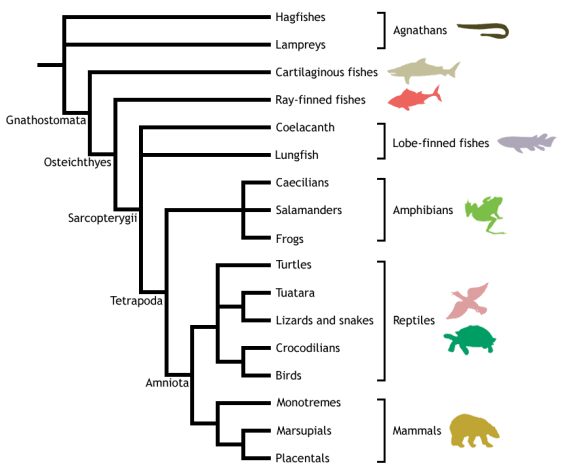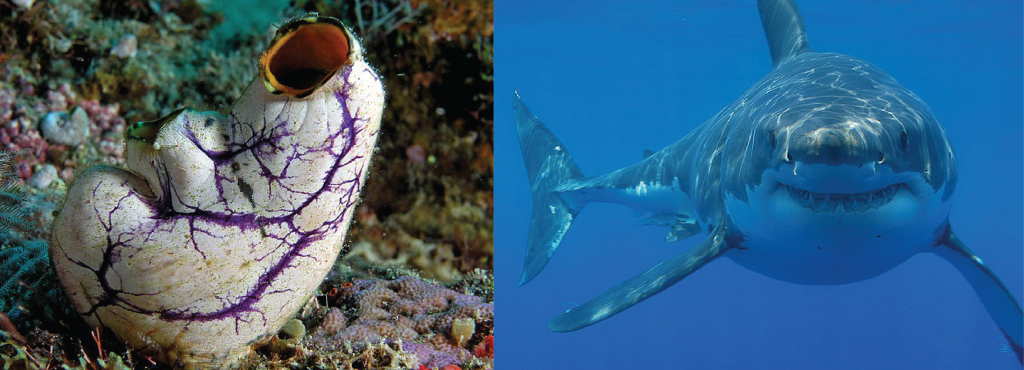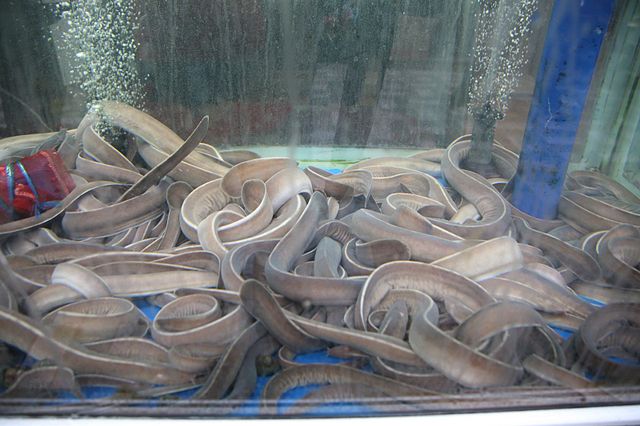Hagfish, or “Slime Eels” (Slimåler in Norwegian, helpfully), are a group of deep-sea living fish that are most famous for the truly apocalyptic amounts of slime they can release when disturbed. In South Korea, they are eaten as a delicacy (and they are very nice – a bit like herring/sild but without the aftertaste). Unfortunately, when a truck transporting these delicacies overturns….
This happens.

But Hagfish are important for more than their culinary value. They have risen to become the main character of a major evolutionary debate. One which greatly affects what we know about our own evolutionary history. And this is the subject of the most recent paper involving a member of the KEG group, “Hagfish genome elucidates vertebrate whole-genome duplication events and their evolutionary consequences”.
Hagfish are one of the earliest diverging groups of vertebrates. Sometimes, you might hear the term “basal” used to describe this, but we’re trying to move away from that in phylogenetics: hagfish and lampreys aren’t less complex than humans, but rather complex in a different way. What it does mean is that we share a common ancestor with them about 500 Million years ago, and we’ve been going our separate ways since.

Now, in those 500 million years or so, a lot has changed between us and our slimy cousins. I’ve gotten some nice opposable thumbs that are helping me type this blog post, for one. But how much has changed is a big question.
Compared to our closest non-vertebrate relatives, humans seem to have gone through two whole genome duplications. But without genomes from hagfish and lampreys, we don’t really understand where that happened. Sharks have gone through those same two whole genome duplications, too, but tunicates haven’t so we know that they both happened somewhere between the Sharks and Sea Squirts.

This is quite a big gap.
But what does a Whole Genome Duplication really mean? Well, that’s the other huge question – some evolutionary biologists think that these duplications helped drive a lot of the innovations that are important to vertebrates. Cool and radical new ideas on the Cambrian sea bed. Ideas like – a spine and fleshy eyeballs.
Which were really very avant-garde back then. Fashions were different.
Others believe that the Whole Genome Duplication might have been involved somehow, but was really more of an assistant to the vertebrate revolution. Opening the door but not pushing the vertebrates through.
So this paper asks two key questions. When did those two Whole Genome Duplications happen? What did they actually mean?

So the first question, the timing is important. Now we have the extra hagfish genome we can pinpoint when the two vertebrate whole genome duplications happened – one happened just before the hagfish and lampreys diverged from the other vertebrates, and one happened just afterwards! to make matters a little more exciting, you might notice an additional CR there too. Remember how I said earlier I didn’t like the word “basal”? Turns out, since splitting off from the lineage that leads to humans, the lamprey and hagfish decided to have a Whole Genome Triplication of their own. Good for them.
The second question is a bit tougher to talk about, and needs a big figure of its own:

This figure might seem difficult to understand at first, but it’s conveying something very simple in a graphical way. These two axes represent all the diversity in morphology that you see across vertebrates – it’s trying to represent in a single graph the differences in physical appearance between a tuna and a deer. The phylogenetic tree from the figure above this one is linking all the coloured dots, and each coloured dots is a species of animal.
But because we know about this Lamprey and Hagfish genome triplication event, and we know about another duplication event (one that was specific to some kinds of fish) we can use that to answer the question of whether those whole genome duplication events were really responsible for driving all the diverse forms we see in vertebrates, from birds and mammals to fish and frogs.
And the answer is, succinctly, not really! The diversity of vertebrate forms that comes significantly after the two whole duplication events is quite high, and we don’t see the hagfish-lamprey triplication event drive some kind of explosion of different kinds of hagfish and lamprey either. So while a duplication event might open the door, there are different evolutionary players that pushed our ancestors through.
So, what did I do in all this? Vision! As you might remember from my other works on snakes and tardigrades, I really like the evolution of sight – and the evolution of those squishy eyeballs is a pretty exciting bit of the vertebrate story. So I surveyed the diversity of visual genes that were available in hagfish and lampreys, and then compared them to the same visual genes across the dataset to better understand the development of sight as a whole in the group. Here, we found out that the hagfish has lost quite a few of genes that help regulate and assist with vision, rather than never possessing them in the first place. This suggests that a visual lifestyle might be something that we shared with the shared ancestor of us and the hagfish, rather than it being a later development. In a massive paper like this, there are a lot of exciting, smaller, underlying stories too, and mine is more one of those. A little b-plot of research that ties neatly into the whole for a rounded conclusion to a really exciting piece of research. It was an absolute privilege to be involved with all these great people in the project, and I want to finish with an especial congratulations to Juan Pascual-Anaya who led such an impressive study with good humour and intellectual rigour throughout.
(Featured image: a photo of a tank of the studied Hagfish, Eptatretus burgeri taken by Junho Jung https://commons.wikimedia.org/wiki/File:Korea-Busan-Haeundae_Market-Inshore_hagfish-04.jpg)
![]()
